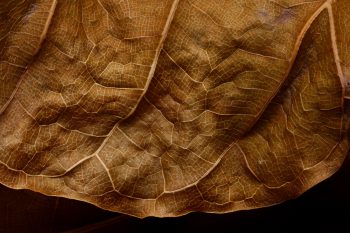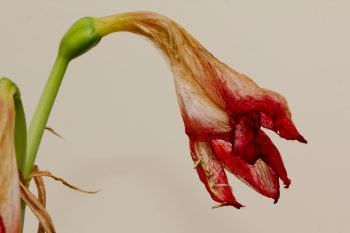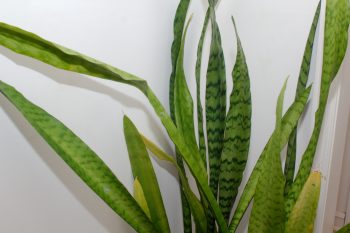I came into the office a bit more than an hour early today so the light was different to what it normally is. There is a half circle window near my office with a pothos plant (Epipremnum aureum) hanging in front of it. Together they cast this shadow on the plain, blank wall.
Tagged With: Houseplant
Blank Wall
Kalanchoe
I didn’t get a chance to go out today to take any pictures. By the time I got around to it, it was almost 10:00 PM so I took some pictures of houseplants. We have a few Thanksgiving cactus plants Schlumbergera truncata that have started to bloom and I got a few decent pictures of those. Then I moved on to this Kalanchoe variety. The genus Kalanchoe has about 125 species with only one species from the Americas. Most are from southern and eastern Africa and Madagascar while a few are from southeast Asia and China. This one is not in bloom but was started from one of the small plantlets (or bulbils) that grow along the margin of the leaves, as you can see in this photograph.
Schlumbergera truncata (Thanksgiving Cactus)
Our Thanksgiving cactus (Schlumbergera truncata) is blooming right on schedule this year. It’s such a cheerful color to brighten up the kitchen and I’m happy for it. It’s a fairly unassuming plant most of the year but as with many cacti, its flowers are remarkable. We have a half dozen of them and some are doing better than others but they are relatively easy plants, not asking for a lot of attention, which is good, because they really don’t get much from us. And yet, this is what they give us.
Echeveria Flowers
It snowed lightly this morning but by the time we were home from church it had all turned to rain. It was a fairly heavy rain and a fairly gloomy, cool day. Cathy and I decided we’d like to see a little green so we went to Behnke in Beltsville to spend a little time in their greenhouse looking at house plants. There were a few things we were interested in but didn’t actually buy anything this time. These little yellow flowers are on what I think is an Echeveria, although I didn’t actually check and often they are labeled simply “succulent”. It was a nice outing and a nice way to spend a cold, rainy Sunday afternoon.
Schefflera Leaves
This is one of our more successful houseplants and it’s one I can recommend to people who don’t have particularly green fingers. It’s not very needy and it’s happy in a wide range of conditions. It does best with a very bright, south or west facing window but it can survive with less. This is one of the houseplants that we put outside during the summer, making sure it isn’t in full sun during the hottest part of the day, which can be a bit too much for it. This one is in a pot with a small, purple leaved rubber plant (Ficus elastica).
Kalanchoe daigremontiana
We have two Kalanchoe plants. This one is Kalanchoe daigremontiana (a.k.a. Bryophyllum daigremontianum) and it’s a pretty little thing, although our plant isn’t particularly robust. Most of our house plants have been somewhat neglected lately. We have lots of excuses, such as the disruption from the renovation project, Solomon’s cage (and Solomon, of course) being moved in front of some of them, or the fact that it’s winter and some of them do better outdoors, during the summer. I do try to get at least a little watering done now and then and we have a small mint next to the kitchen sink. When it starts to wilt, I know it’s watering time.
Phalaenopsis Orchids
I had planned to go out and take some pictures around my office building today. The sky was clear as I came in this morning, which was welcome after the two days of soaking rain we’ve had. By midday, however, the sky had clouded up again. It didn’t rain but was a lot more gloomy than the morning promised. Of course, colors are often more intense under an overcast sky, but I never managed to get outdoors to take advantage of that. By the time I got home, of course, it was dark. That’s one problem with this photo-a-day thing in the winter. I have a lot less opportunity to get pictures outdoors. I can stop on the way to work or go out during the day, but otherwise, I’m confined to pictures in the house (or night-time pictures, which are hard). But we have this orchid in bloom, so I got pictures of it and that will have to do.
Bromeliad
The couple that bought Margaret’s house gave her this bromeliad at closing, along with a very sweet card thanking her for choosing their offer and making their “dream of home ownership a reality.” We’re not very experienced with growing bromeliads but what I’ve read seems to indicate they aren’t all that difficult. They don’t need to be watered in the usual way and many of them don’t even have roots that take in nourishment. Instead, the cups formed by their leaves should be filled with water and that’s really all there is to it. They are not terribly long lived and often die after blooming but of course their blooms are what they are mostly grown for. They will often produce off-shoots, which can be cut off and potted up to replace the “parent” plant.
I once designed a house that has a conservatory inspired in large part by the Peirce-duPont House at Longwood Gardens, in Kennett Square, Pennsylvania. In that, I imagined at the very least a section devoted to tropical plants, including ferns, orchids, and bromeliads. I’m very unlikely to ever build the house, of course, but I can picture it in my mind’s eye and enjoy the serenity of the indoor garden, sitting in a wicker chair with a pot of tea and a good book.
African Violets
We’ve had mixed success with houseplants over the years. When we’re not too busy, we can do reasonably well and houseplants thrive. When we’re busier, anything not particularly resilient is in pretty significant peril. Lately we’ve done reasonably and we have two African violet plants, cultivars of Saintpaulia ionantha, that arew doing well and blooming. We also have a iddle leaf fig (Ficus lyrata) that Dorothy started by rooting a leaf. It’s now about 6 feet tall and seems quite happy.
Winter-flowering Begonia
With more than 1,800 species, the genus Begonia is one of the largest genera of flowering plants. That doesn’t take into account a multitude of hybrids and cultivars. I have no idea what this variety is, but it’s a pretty, winter-flowering begonia and that’s all that really matters. There are hardy begonias but this isn’t one of them. So, it’s on a table in our dining room and provides some color, along side two deep purple African violets and sheltered by a large (and growing) fiddle-leaf fig (Ficus lyrata) and a fairly old pathos plant (Epipremnum aureum).
Clivia miniata (Natal Lily)
I have had this Clivia for quite a few years now, since a coworker left it to me when she stopped working here. I had it at home for a while but two years ago I brought it to my office and it’s been doing pretty well. It gets literally no direct sun light with my north-facing window but it seems to be doing well with that. They don’t tolerate frost and are grown as houseplants here but they must be wonderful in a garden in their native South Africa and Swaziland. The blooms, as you can see, are quite bright and vary a bit from the orange seen here to yellow and nearly red. Thank you, Emily, for this long-lasting gift.
Schlumbergera truncata (Thanksgiving Cactus)
Occasionally, a little bit of benign neglect is exactly what a plant needs to thrive. This Thanksgiving cactus (Schlumbergera truncata) has been on the floor of the kitchen, underneath Solomon’s cage, for a while and although it gets watered from time to time, it isn’t getting the attention it probably deserves. That’s generally a recipe for dead plants, but this one gut just enough attention, apparently, because it’s come into bloom a few weeks ahead of the holiday it’s named for. I took a few photos of entire flowers but they are mostly white with only a very small amount of pink and therefore don’t show a lot of detail in a photograph. I thought this photo of the pale stamens with their pollen and the red and pink style was nicer.
Ficus lyrata Leaf
Dorothy rooted a leaf from a fiddle-leaf fig (Ficus lyrata) a while back and it’s done pretty well. We had it in the kitchen for a while and it got strong enough to stand without support, which is nice. We have since moved it to the dining room, where it’s a little less in the way, but the lower leaves don’t get any sun and they recently dried up and fell off. I really love the texture of the leaves as well as the patterns of their veins. After taking this photo (and some others) I happened to leave them on the sideboard. Cathy wondered where in the world these huge leaves had come from and what they were doing there. They’ve been thrown away now.
Ficus microcarpa Bonsai
In the wild, this species of fig is a tree growing to over 100 feet in height and with a spread of 200 feet. This specimen is, obviously, a little smaller. The tree, variously known as the Chinese or Malayan banyan or the curtain fig, is native from China through tropical Asia and the Caroline Islands to Australia. As a houseplant it is a good choice for bonsai, taking training quite well. In the case of this plant, it is what is known in the trade as a ginseng ficus. The “stems” are actually roots. The plant is allowed to grow with these fleshy roots underground and then the plant it re-potted so that they are above ground, giving the appearance of ginseng roots. This was a gift to Dorothy from her friends, Rachel and Andrew.
Rieger Begonia Leaf
My mom was given a Rieger begonia a while back and she gave it to me. It was covered in pink blossoms when I got it and it bloomed for a while but since then it’s been growing but so far hasn’t rebloomed. I’m not sure how likely it is to rebloom but it seems happy enough in a west-facing window along with a pothos plant (a.k.a. Devil’s ivy, Epipremnum aureum), a jade plant (Crassula ovata) that Dorothy started from a leaf, an African violet (Saintpaulia species), and with a large, fiddle leaf fig (Ficus lyrata) growing in a pot on the floor next to them.
Amaryllis
We have two amaryllis bulbs from last year that we pretty much neglected after they finished blooming. They had leaves for a while but we stopped watering them and they just sat on shelves in the kitchen after that. They normally bloom around Christmas time, which is lovely, of course, but we weren’t paying them any attention. A week ago I notice this one had sent up a shoot with a bud on top so it got a little water. It has rewarded our neglect with two lovely blooms. It now has a spot on the kitchen counter. I had to add two stakes to hold it up because the flowers are pretty heavy and the pot it’s in is not.
Dried Amaryllis Flower
This is the same amaryllis flower that I posted a photo of a week an a half ago (see Thursday, March 12, 2020). As you can see, it’s dried out but interestingly has retained some of it’s color. Since taking this photo, I’ve cut the stem so we won’t get any seeds. They are so easily available in bulb form late in the year that we buy one most years. This one came back into bloom, a little later than expected but without much of any attention having been paid to it in the meantime.
Snakeplant (Sansevieria trifasciata)
Dorothy’s former second grade teacher gave me this snakeplant (Sansevieria trifasciata, also known as viper’s bowstring hemp) when she and her husband moved to Florida a year after Dorothy had her as a teacher. So, I guess I’ve had it about fifteen years. It was in my office most of that time. Then, in March when we all started working from home, I sort of assumed it would die. I happened to go into the office ten weeks into that and was surprised by how healthy it was, although the pot was bone dry. I brought it home, along with a Natal lily (Clivia miniata) and a spider plant (Chlorophytum comosum), both of which were also hanging on. All three have recovered nicely and I brought this and the clivia back in for the winter. As you can see, it’s got a few issues, but all things considered, I’m just happy it’s still with us.
Schlumbergera truncata (Thanksgiving Cactus)
This Thanksgiving cactus (Schlumbergera truncata) is somewhat neglected though most of the year. That’s actually a good thing as they really don’t want to much attention. It sits on a shelf in our kitchen (breakfast room, really) and gets watered only occasionally. Then, one day around this time of year, you look over and it’s covered with these beautiful blooms. Naturally we move it to a more prominent position while it blooms and then it will go back into relative obscurity for the rest of the year.
Schlumbergera truncata (Thanksgiving Cactus)
This is the second of our Thanksgiving cacti (Schlumbergera truncata) to bloom. The first was mostly white (see Monday, November 23, 2020) and this one, as you can see, is mostly magenta. The third, also magenta, is blooming now, as well. Their flowers are really attractive and I think especially so when shown against a dark background. In this case, the background is the outdoors at night (our kitchen door) with the flower lit by my camera’s flash. S. truncata can be differentiated from the Christmas cactus (S. russelliana) by the pointy ‘teeth’ along the edges of the segments and the fact that the flowers are not symmetrical (the top half is different to the bottom half).




















